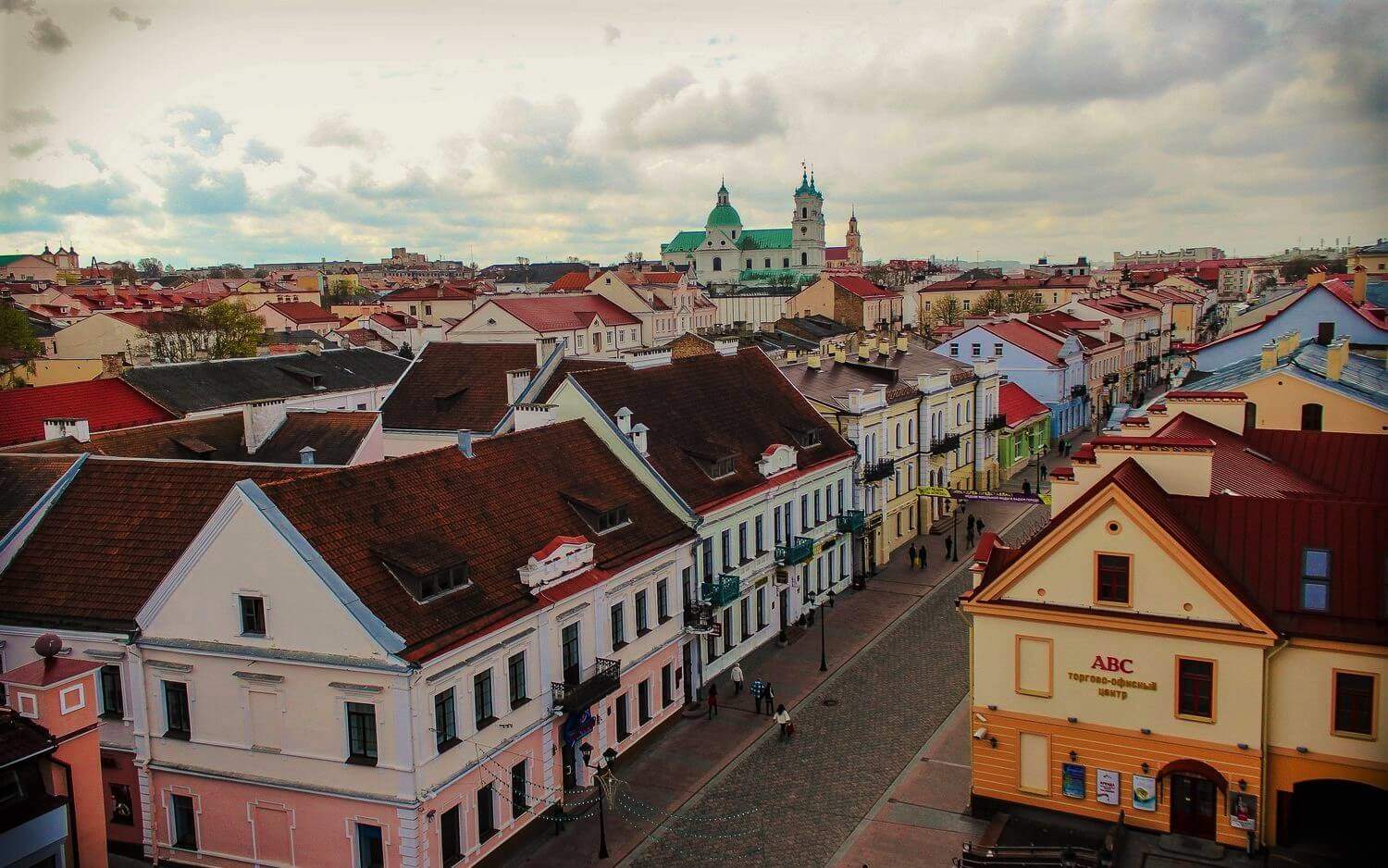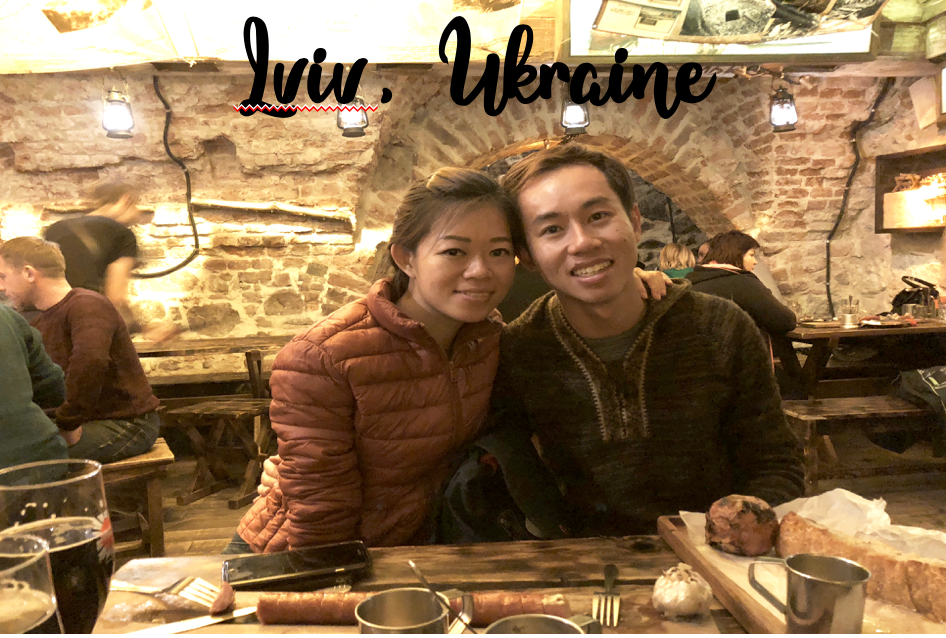
With plenty of intact pre-WW2 architecture, Hrodna (Grodno in Russian) is arguably Belarus’ prettiest city. It has a decidedly European flavour, much of it derived from its central pedestrianised street, ironically named vul Savetskaya (Soviet St). The Soviets demolished many of the city’s beautiful old churches after the war. Several have been rebuilt since, and their baroque profiles now dominate the central skyline.

Grodno is easily accessible from Minsk with several daily departures. For us, we took a minibus from Brest to Grodno. Having arrived in Grodno in the evening, we settled in at our apartment and went out for a walk. Night fall came quickly because it was winter time and daylight hours were shorter. We enjoyed taking in the beautiful night lights around Grodno. Above shows the Cryllic writing of Grodno in Belarussian.

Since 2019 was approaching, the town had some decoration for the new year. They even had a symbol of the pig as it will be the Year of the Pig in 2019, even though Belarus does not follow the Lunar calendar.
Grodno has some interesting statues scattered around the city centre. Even the dustbins are cute enough to attract people to throw their litter inside.
St. Francis Xavier Cathedral is a Roman Catholic cathedral in Grodno, Belarus. Originally a Jesuit church, it became a cathedral in 1991, when the new diocese of Grodno was erected. The church is visible from different parts of the city and has been well-preserved in its original form over the years. 
A reminder of the war which killed many lives.
Grodno Regional Drama Theatre. Residents of the city are proud of the local drama theater, which is located on the high bank of the Neman river. People call it “opera”, and many consider it to be a symbol of Grodno.


We wanted to go to this restaurant along the Nema river for lunch, but unfortunately it is closed. Imagine the crowds during summer as people would sit at the patio to enjoy the sunshine. As you can see, it is really gloomy in Belarus during winter time.


The entrance to the New Castle. It was built close to the Old Castle during the years when the city was under the rule of the Polish King and the Grand Duchy of Lithuania. The style of the New Castle varies greatly from the old one, but architects and builders have managed to create them into a single estate complex. The New Castle can be divided into two parts, one for the residents of the owners of the castle and the other one was used for meetings.

There are many paintings in the museum. Today, the New castle is also a home for a branch of the Historical and Archaeological Museum with a beautiful garden with acacias.

The interior of the museum is quite spacious and chandeliers adorn the ceilings.
It was surprising to find pieces of Southeast Asian artefacts in the museum. It shows the close ties between the two countries. 
There was a segment on Natural History and various animal specimens on display.

The polar bear is endangered due to the melting ice caps and sea level rise, which can be pinpointed to the effects of climate change.



Over at the Old Castle, it is situated in a picturesque location overlooking the banks of the Neman River. The castle has such a long history, it has changed hands from the Grand Duke of Lithuania to the King of Poland. In the 17th century, the castle was destroyed during a war and 40 years later, the castle was ravaged to the ground by a fire. Today, the castle is still undergoing restoration works on the exterior. The bridge on which I am standing on connects the castle with the city. 
The museum inside the Old Castle is quite similar, but it focuses more on the war history of the country. There are various artefacts depicting the local customs. 

There are many exhibits showing the Soviet times, of which Belarus was one of the more important countries in the region, due to its proximity to Russia. Till today, Belarus still seems like a part of Russia and trains passing through the Russian-Belarusian border are not really considered international trains and it is difficult for foreigners to cross the international border as they have to forego the visa-free regime for Belarus. 
After the war, Grodno became a major centre for manufacturing and industries. Cards such as these (above) were produced in Grodno and there were also entrepreneurs who made bicycles. 
On the ground floor of the Old Castle, there is a Natural History museum exhibit which reminded me of the Natural History Museum in London. Of course the one in Grodno is less maintained and not comparable. It was interesting to read more about the various animals on display. 

After sightseeing, we dropped by the Central post office to get some stamps. I am surprised to see that Postcrossing is such well-advertised here compared to Singapore. There are even special postcards produced just for Postcrossing. The selection of postcards was great for me and I enjoyed my visit to the post office.
Outside the post office, there is a model of a post truck used to deliver the mail, rain or shine.
The Holy Intercession Orthodox Cathedral is also worth checking out. It has a very interesting exterior decoration, framing of windows and entrances. The church is a place of religion and worship, one of the examples of multiculturalism in the country.

Leaving Grodno by train as we make our way back to Minsk. The journey between Grodno and Minsk takes about 4 hours but there is a huge difference between the sleeper trains and the inter-city trains which run faster.
Overall, we enjoyed our stay in Grodno. Although none of my Singapore friends had visited Grodno, it was recommended by a Belarusian friend to visit due to the well-preserved buildings. There were groups of Polish tourists coming from across the border on group tours, but in general the city is not swarming with tourists, which makes it pleasant to walk around and explore on your own. If there were more time, we would have explored other castles around the region or even cross over the border to Poland! Unfortunately, following the terms of the visa-free regime, we needed to arrive and depart Belarus through Minsk airport.
There are such interesting and rich cities, like Lida, Slonim, Novogrudok and the famous Augustow canal. Also worth visiting are the castles that Grodno region is famous for, such as Mir, Krevo, Lida and Lubcha Castles.


